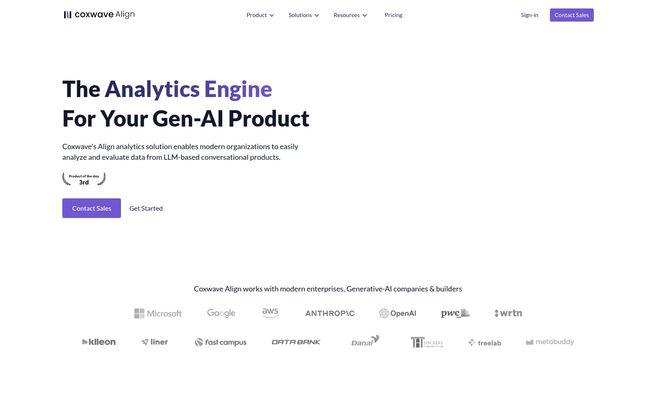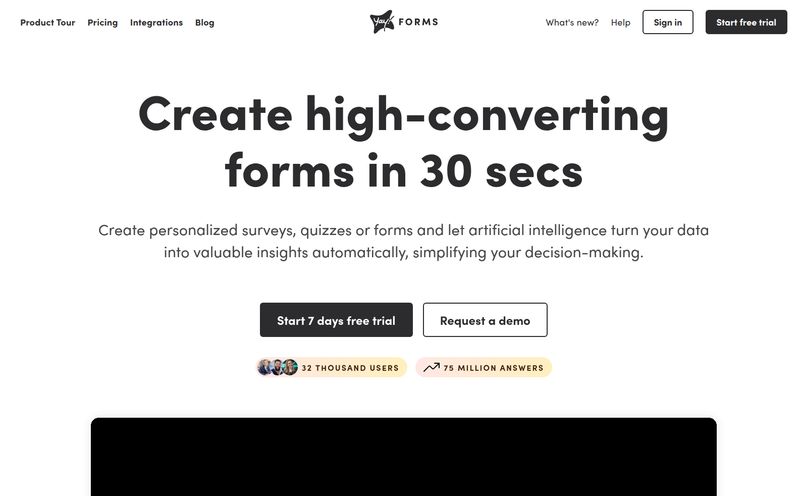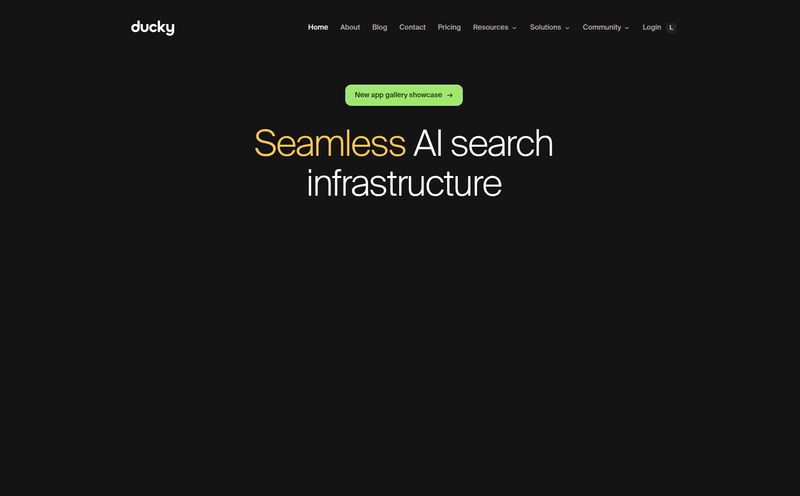You’ve spent countless nights fueled by coffee and sheer willpower, wrangling APIs, fine-tuning models, and finally… you launched it. Your very own Generative AI product. A chatbot, a copilot, a content creator—whatever it is, it's live. High-fives all around. But after the launch-day confetti settles, a quiet, slightly terrifying question starts to echo in the office:
Now what?
How do you know if it's any good? Are users loving it, or are they getting frustrated and leaving? Is your shiny new AI hallucinating more than a backpacker at a full moon party? These are the questions that keep product managers and developers up at night. For years, we've had tools like Google Analytics and Hotjar to understand website traffic, but the world of conversational AI has been a bit of a black box. Until now, maybe.
I’ve been hearing some buzz about a platform called Coxwave Align, which claims to be the "analytics engine for your Gen-AI product." As someone who lives and breathes data, traffic, and trends, my curiosity was definitely piqued. Is this the missing piece of the puzzle for the thousands of new AI products flooding the market? Let's take a look.

Visit Coxwave Align
What is Coxwave Align, Really?
Let's cut through the marketing jargon. Coxwave Align is essentially an analytics platform built specifically to understand the conversations happening between your users and your AI. Think of it like a specialized mission control for your chatbot. While you're busy building the rocket, Align is the dashboard full of screens telling you about engine performance, trajectory, and whether the astronauts (your users) are happy or about to mutiny.
It’s designed to do three core things, which they neatly package as: Monitor, Analyze, and Evaluate.
- Monitor: Watch the interactions as they happen. See what people are asking, how the AI is responding, and where things are going right or wrong in real-time.
- Analyze: Go beyond just watching. Dig into the data to spot trends, understand user needs, and figure out why certain conversations are failing.
- Evaluate: This is the big one. Measure the quality of your AI's responses. The goal is to systematically reduce those pesky hallucinations and improve the overall user experience.
Basically, it helps you move from hoping your AI works to knowing how it works and how to make it better. A pretty compelling pitch, I have to say.
The Danger of Flying Blind with Your LLM
I've seen it happen. A company pours a ton of resources into a new AI assistant. It launches, and the initial feedback is… okay. But engagement drops off a cliff after a few weeks. Why? The team has no idea. They don't know what questions are stumping the bot or what features users are desperately trying to find. They're flying completely blind.
Without a dedicated analytics tool, you're just guessing. You might think your bot's personality is charmingly quirky, but the data could show it's just confusing people. You might believe your AI is providing accurate answers, but a small percentage of critical, high-value users could be getting completely fabricated nonsense (we're talking hallucinations). These issues don’t just create a bad user experience; they erode trust and can kill a product before it ever finds its footing.
This is the problem Coxwave Align is trying to solve. It’s built on the premise that you can’t improve what you can’t measure. A sentiment I wholeheartedly agree with.
How Coxwave Align Tries to Clear the Fog
So, how does it actually deliver on its promise? I took a peek under the hood at its features, and a few things stood out to me as genuinely useful for anyone in the AI product space.
Features That Seem to Actually Matter
First off, the setup is reportedly a breeze. They claim developers can get the SDK integrated and start sending data in less than 15 minutes. In a world of complex integrations, that’s a huge plus. But the real meat is in the analysis tools. The real-time conversational data dashboard gives you that immediate pulse-check on system health. It’s your first line of defense.
What I find realy interesting is the natural language search for chat data. Instead of writing complex database queries, you can supposedly just ask questions like, “Show me all the conversations from last week where users asked about pricing and the bot failed.” This is a massive time-saver and makes data accessible to non-technical team members like product managers or marketers. It's a bit like having a conversation with your own data, which is fitting.
They also have something called a Copilot for subjective data analysis, which sounds like an AI to help you analyze your AI. A bit meta, but I like it. This tool helps synthesize feedback and identify themes in the data, turning a mountain of chat logs into a handful of actionable insights. That's the holy grail of analytics: not just data, but what to do with it.
Let's Talk Security and Deployment
In today's world, especially when dealing with user conversations that could contain sensitive information, security is non-negotiable. This seems to be an area where Coxwave Align is putting its foot down, and hard.
Fort Knox for Your Chat Logs
They prominently feature their SOC 2 and GDPR compliance. For those not in the weeds, this is a big deal. SOC 2 is a rigorous auditing procedure that ensures a company securely manages data to protect the interests and privacy of its clients. It's the gold standard. GDPR is the European Union's strict data privacy regulation. Seeing these badges up front tells me they’re serious about enterprise clients and understand that trust is paramount.
Cloud or On-Premise? You Choose.
Coxwave offers two main solutions, which shows a good understanding of the market:
- Coxwave Align Cloud: This is the plug-and-play version. Quick setup, hosted by them, perfect for startups and teams that want to move fast without managing their own infrastructure.
- Coxwave Align Enterprise: This is the on-premise solution. Your data never leaves your servers. This is critical for organizations in finance, healthcare, or any other industry with extremely strict data residency and security requirements. It requires more setup, naturally, but for some, it's the only option.
Providing this flexibility is smart. It allows them to cater to both the scrappy startup and the Fortune 500 company.
The Elephant in the Room: How Much Does It Cost?
Ah, the pricing page. The moment of truth for any new tool. And in the case of Coxwave Align… there isn’t one. The dreaded “Contact Sales” button.
Now, I’m not gonna lie, this is a pet peeve of mine. I prefer transparent pricing. However, in the B2B and enterprise software world, it's common. It usually means the pricing is customized based on volume, specific needs, and whether you're going for the Cloud or Enterprise solution. It signals that their target customer isn't a solo developer trying it out for a weekend project, but a business with a real budget.
So, while it’s a con that you can't see the price tag upfront, it’s also a hint about who this product is built for. Be prepared to have a conversation and get a custom quote.
My Honest Take as a Data Junkie
So, what’s the verdict? I haven’t run a year-long study, but based on what I see, Coxwave Align is solving a very real, very current problem. The Gen-AI boom has created a new set of challenges, and the old analytics tools just aren't cut out for the job.
The focus on actionable insights over vanity metrics is spot-on. The natural language search is a potential game-changer for usability. And the heavy emphasis on security shows they understand their target audience. The social proof is also pretty strong, with names like Microsoft and Anthropic listed as collaborators or customers.
On the flip side, the lack of public pricing will be a hurdle for smaller teams. And some parts of the ecosystem, like their “Align Academy,” are still listed as “coming soon,” which is typical for a newer platform but something to be aware of.
Ultimately, if you have a live Gen-AI product and you feel like you're navigating in the dark, getting a demo of Coxwave Align seems like a no-brainer. It could be the difference between a product that fizzles out and one that truly learns, adapts, and wins over its users.
Frequently Asked Questions
- What exactly is Coxwave Align?
- Coxwave Align is a specialized analytics platform for companies with LLM-based products like chatbots or AI copilots. It helps you monitor, analyze, and evaluate user interactions to improve your AI's performance and reduce errors like hallucination.
- How long does it take to set up Coxwave Align?
- According to their website, the cloud version can be set up very quickly. The SDK integration for developers is designed to take less than 15 minutes to start collecting data.
- Is my conversational data secure with Coxwave Align?
- Security seems to be a top priority. The platform is SOC 2 and GDPR compliant. They also offer an on-premise Enterprise solution for organizations that need to keep all their data within their own infrastructure.
- Who is the ideal user for Coxwave Align?
- It seems best suited for businesses, from startups to large enterprises, that have launched a generative AI product and need deep insights into its performance. Product managers, engineers, and data analysts in the AI space would be the primary users.
- How much does Coxwave Align cost?
- Pricing is not publicly available. You need to contact their sales team for a custom quote, which is typical for enterprise-focused software. The cost will likely depend on data volume and the specific solution (Cloud vs. Enterprise) you choose.
- What's the main difference between Align Cloud and Align Enterprise?
- Align Cloud is a hosted solution that's fast to set up and managed by Coxwave. Align Enterprise is an on-premise solution that you host on your own servers, giving you maximum control over data security.
Final Thoughts
The age of “build it and they will come” is over—if it ever truly existed. In the competitive AI space, the mantra is “build it, measure it, and make it better.” Tools like Coxwave Align are not just nice-to-haves; they are becoming essential infrastructure for building successful AI products. If you're serious about understanding your users and improving your bot's quality, you need a way to, well, align its performance with user expectations. This tool might just be the way to do it.
Reference and Sources
- Coxwave Align Official Website: https://www.coxwave.com/align



